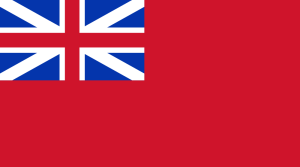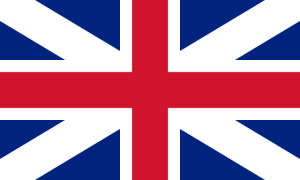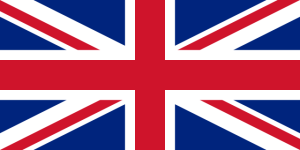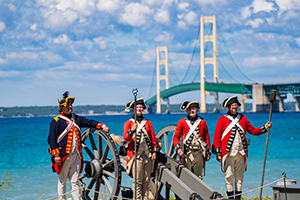In the late 18th century, Michilimackinac served as an important economic, diplomatic, and military center for the British government. Although one of the most remote outposts of the British empire, Michilimackinac held the key to British influence in the Great Lakes, and it seems only logical to assume that the British projected this regional power by flying a flag over their fort on the Straits of Mackinac.

In a September 1774 letter to Lt. Col. Samuel Cleaveland of the Royal Artillery, newly-arrived Capt. Arent DePeyster made a rare reference to a flag when he requested a “large Ensign” be sent to Michilimackinac. For many years, historians assumed that DePeyster was referring to the Red Ensign, which served as the flag of the Royal Navy in the 18th century. However, reviewing the entire letter reveals a bit more ambiguity in DePeyster’s request:
Sir- I was informed by my predecessor that the Colours of this Garrison belonged to a Master of a Vessel of whom he had borrowed them to hoist upon particular occasions. They are at length demanded by the owner, by which means the Garrison remains without Colours which are absolutely necessary to return the compliments of tribes of Indians when they come on matters of any consequence to the Government. They serve to display a certain necessary dignity, therefore I am informed by the standing orders of this post that the Commanding Officer of the Artillery [Cleaveland] is to be applied to for Colours when wanted. I take the liberty of troubling you upon this occasion and shall be glad to have a good large Ensign sent as early in the spring as possible.
Although it is unclear if he was specifically requesting a Red Ensign, DePeyster indicated that the flag was not flown every day, instead only being hoisted for special events or “particular occasions.” British officers at other posts in Canada confirmed this practice, noting that in some garrisons flags were only hoisted for holidays (the anniversary of the king’s coronation, St. Patrick’s Day, St. David’s Day), on Sundays, or when the post was directly threatened by enemy forces. In many cases, these same officers reported that their soldiers were hoisting the Union Flag, also known as the King’s Colours, which served as the flag of the United Kingdom of Great Britain.

The trader Peter Pond confirmed the practice of hoisting the Michilimackinac flag for special events in 1775, when he described arriving at the fort with a Native canoe brigade from Wisconsin: “We had flags on the Masts of our Canoes- Eavery Chefe his flock. My Canoes Beaing the Largest in that Part of the Cuntrey and having a large Youon [Union] flage I Histed it and when within a Mile and a half I took ye lead and the Indians followed close behind. The flag in the fort was histed- ye Cannon of the Garreson Began to Play Smartley…” It is interesting to note that the soldiers hoisted a Union Flag over the fort, and even Pond had a Union Flag flying from his canoe.
Whether or not it flew regularly over the fort, the Union Flag observed by Pond in 1775 was almost certainly the primary flag at Michilimackinac. An inventory of ordnance stores at Michilimackinac taken in September 1779 revealed one Union flag and one flag of St. George (the flag of the Kingdom of England) at the post. Historic images of other 18th century British posts, such as Fort George at the Battery in New York City, Fort Niagara, the British camp at the Battle of Lake George, Fort Ontario, Fort Ligonier, Fort Mifflin, and Fort Erie, all depict the Union Flag rather than the Red Ensign.

Today, the Union Flag flies proudly over Colonial Michilimackinac, the modern reconstruction of Michilimackinac as it appeared in the 1770s.









